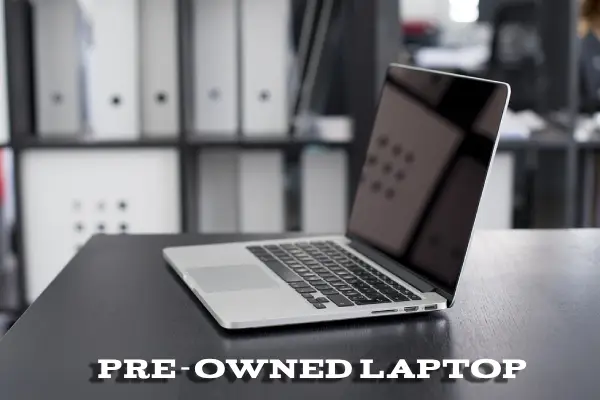1. Perform an Initial Inspection
Begin by examining the laptop’s exterior. Look for any signs of damage, such as dents, cracks, or scratches. Check the hinges to ensure they are sturdy and not loose. A well-maintained exterior can indicate how well the previous owner took care of the laptop.
Your inspection should include all ports and connectors, including USB ports, headphone jacks, HDMI ports, and the charging port. Make sure none of them are damaged or loose. Bring along a USB device or a pair of headphones to test if the ports are functioning correctly.
You will need to power on the laptop and closely examine the screen for dead pixels, discoloration, or flickering. Check for any scratches or cracks on the surface of the screen. Ensure the brightness and contrast are adequate and that the screen displays colors accurately.
2. Battery Life and Charging
Check the laptop’s battery health by navigating to the battery settings. On Windows, you can do this by typing “battery report” in the search bar and running the command prompt. On an Apple Macbook, hold the Option key and click the battery icon in the menu bar to see the battery’s condition.
Another way to check the battery is to plug in the laptop and ensure it charges correctly. Observe the charging indicator light or the on-screen battery icon to confirm the laptop is charging.
3. Performance and Hardware
Find out the laptop’s processor (CPU) and RAM specifications. You can do this by checking the system information in the settings. Ensure the processor speed and RAM meet your requirements. Test the laptop by opening multiple applications simultaneously to see if it runs smoothly without lag.
The type and capacity of the storage drive (HDD or SSD) is just as crucial. SSDs are generally faster and more reliable than HDDs. Verify the storage capacity to ensure there is sufficient space for your needs.
Test the keyboard by typing a few sentences to check for any unresponsive or sticky keys. Make sure all keys function correctly, including special function keys. Test the trackpad by moving the cursor around and performing gestures like scrolling and right-clicking.
Checking Sound and Audio Quality
Play some audio files or videos to test the speakers. Ensure the sound is clear and at an adequate volume. Test the microphone by recording a short audio clip and playing it back. Check the webcam by opening the camera application and ensuring the image is clear and not grainy.
4. Software and Operating System
Check for any available updates and install them if possible to avoid laptops that are running outdated or unsupported operating systems. Check for any pre-installed software or bloatware that might slow down the laptop. It may also benefit you to run a quick scan to check for any potential threats or malware. Verify that the firewall and other security features are enabled and functioning correctly. You don’t want to buy a device already housing a virus!
5. Network Connectivity
Connect the laptop to a Wi-Fi network to ensure the wireless adapter functions correctly. Test the Bluetooth connectivity by pairing the laptop with a Bluetooth device like a smartphone or wireless headphones. If the laptop has an Ethernet port, connect it to a wired network to ensure it works correctly. This step is crucial if you rely on a wired internet connection for stability and speed. Yes, believe it or not, some people prefer not to go wireless.
6. Overall Usability
Restart the laptop and measure the boot time. A fast boot time indicates a well-functioning system and possibly an SSD. Long boot times can be a sign of underlying issues or an older HDD. Use the laptop for a while to check for any excessive heat or noise. The laptop should remain relatively cool and quiet during normal use. Overheating and loud fan noises can indicate hardware issues.
Of course, you want to make sure you’re comfortable using the laptop. Ensure the laptop’s size, weight, and overall design suit your preferences and needs. A comfortable keyboard and screen size are essential for extended use.
7. Final Checks Before Purchase
Ensure the laptop has been factory reset and does not contain any personal data from the previous owner. A factory reset will also help you start with a clean slate and avoid any hidden software issues.
Check if the laptop comes with any accessories such as the original charger, additional batteries, or a laptop bag. Having these extras can add value to your purchase. Or else, you’ll be scrounging around for cords just to use what you just bought.
Ask for any available documentation, including the original purchase receipt, warranty information, and user manuals. This documentation can be useful for future reference and support.
Visit Azusa Mega Pawn for Quality Pre-Owned Laptops!
For reliable, pre-loved laptops at a great price, look no further than Azusa Mega Pawn! Our extensive selection of high-quality laptops is meticulously inspected to ensure top performance and reliability. Whether you need a laptop for work, school, or entertainment, we have the perfect device for you. Meet our friendly and knowledgeable staff who are here to help you find exactly what you need! Visit Azusa Mega Pawn today or call (909) 627-9622 to ask about our current selection. For your convenience, you can also shop our laptop selection online.

